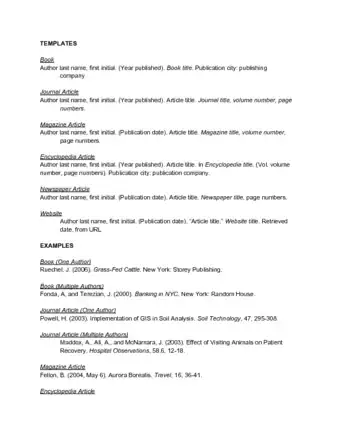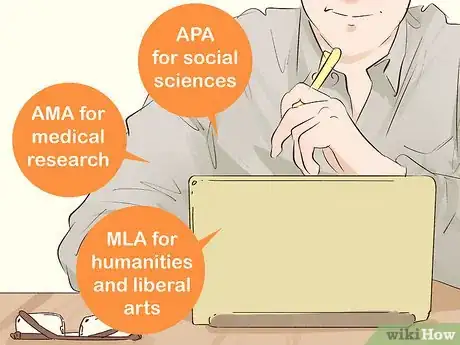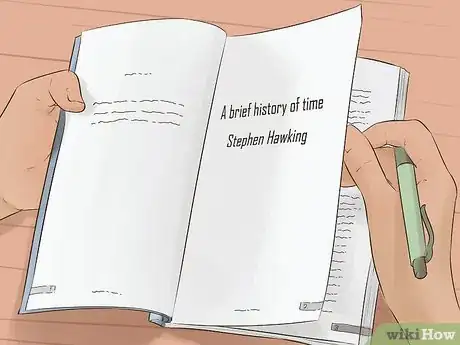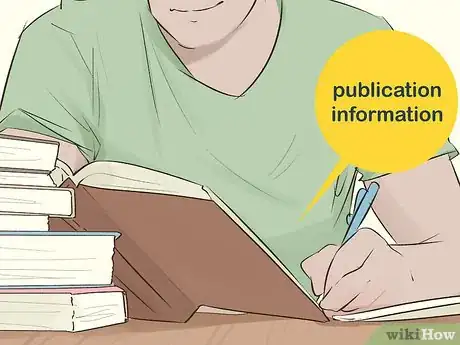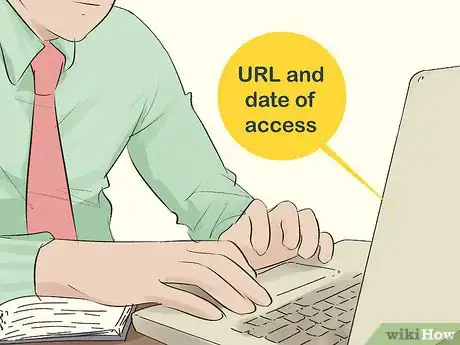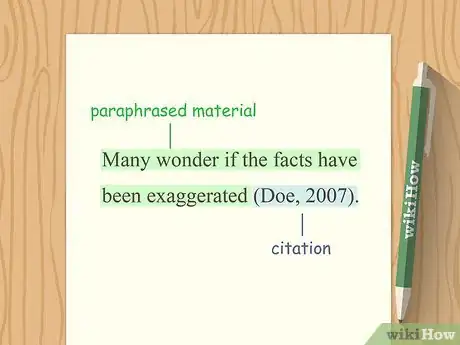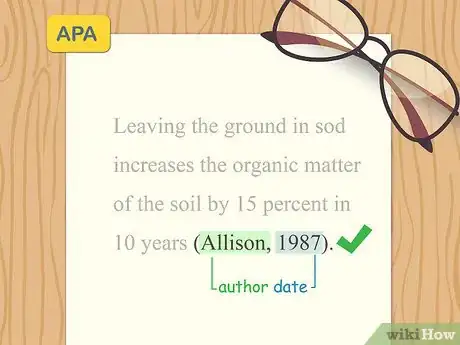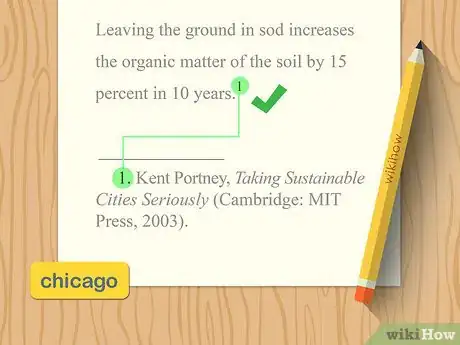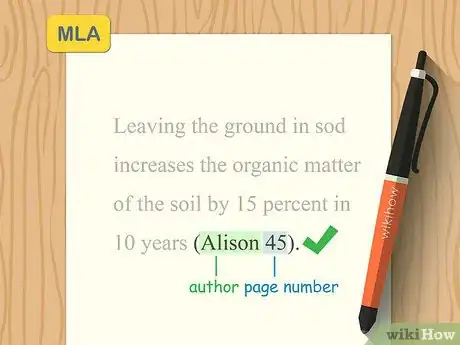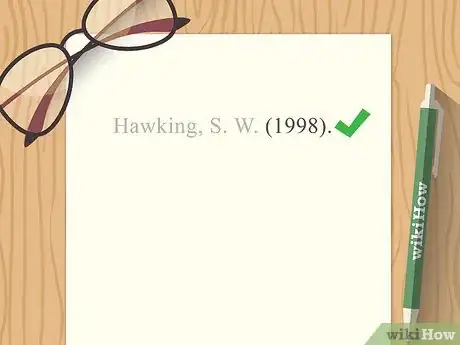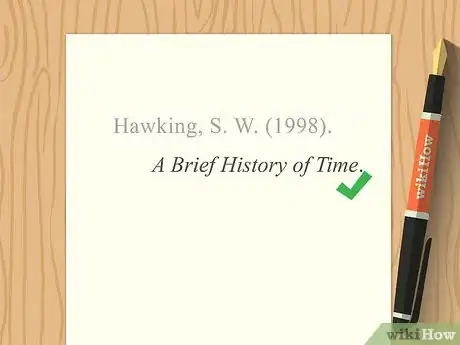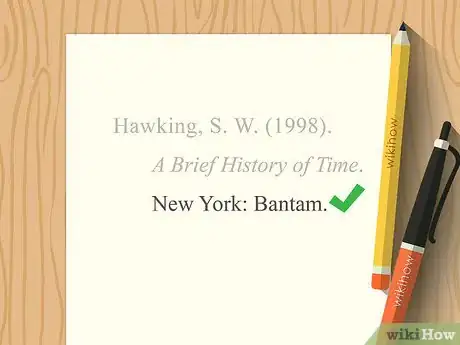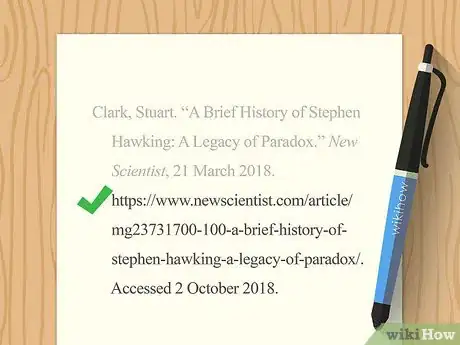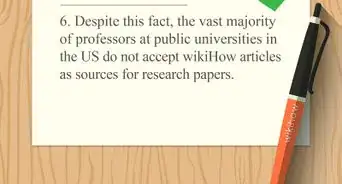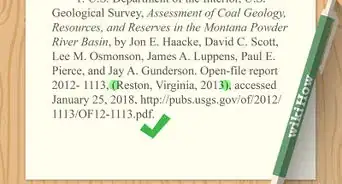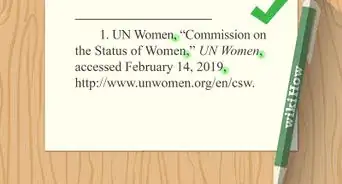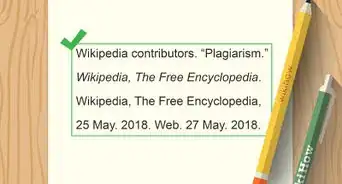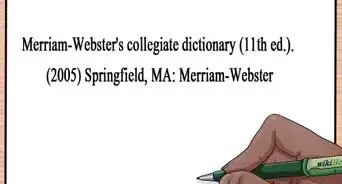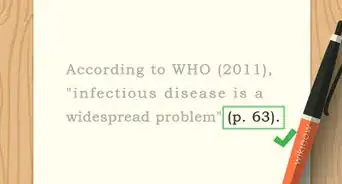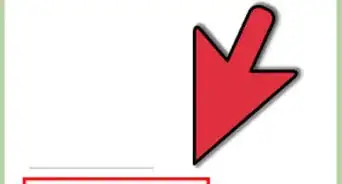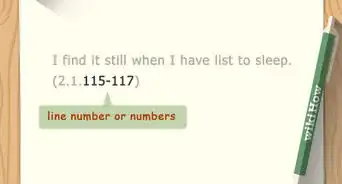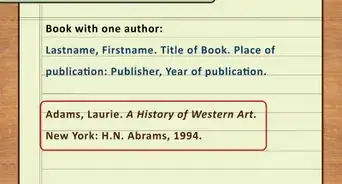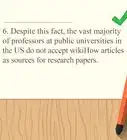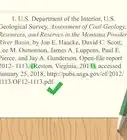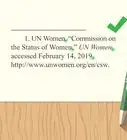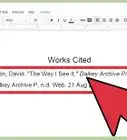This article was co-authored by Diane Stubbs and by wikiHow staff writer, Jennifer Mueller, JD. Diane Stubbs is a Secondary English Teacher with over 22 years of experience teaching all high school grade levels and AP courses. She specializes in secondary education, classroom management, and educational technology. Diane earned a Bachelor of Arts in English from the University of Delaware and a Master of Education from Wesley College.
There are 12 references cited in this article, which can be found at the bottom of the page.
wikiHow marks an article as reader-approved once it receives enough positive feedback. In this case, several readers have written to tell us that this article was helpful to them, earning it our reader-approved status.
This article has been viewed 1,642,592 times.
When you paraphrase or quote information from another source in a research paper, essay, or other written work, cite the original source of the information. Otherwise, your readers believe you are trying to pass this information off as your original thought. Proper citation adds credibility to your work and provides evidence to support any arguments you make. Your citations also give your readers the opportunity to further explore the topic of your work on their own.[1]
Steps
In-Text, MLA, and Chicago Citation Help
APA and Turabian Citation Help
Gathering Information about Your Sources
-
1Determine what citation style you need to use. There are several different citation styles used in different research fields. Ask your instructor or supervisor which style to use for your project. The most common styles used in academic writing are the Modern Language Association (MLA), American Psychological Association (APA), and Chicago styles. You can access the guide for each style online, or check it out of your local library.[2]
- Generally, you'll have full citations listed at the end of your paper. The citation list may be called a reference list, bibliography, or Works Cited, depending on the type of citation style you're using.
- Within the body of your paper, use in-text citations to signal that the material preceding the citation is not your original work. The in-text citation allows your reader to find the full citation at the end of your paper. In-text citations may use the in-line parenthetical, footnote, or endnote style.
-
2Identify the author and title for each source. For every source you plan to use in your research paper, write down the author and title. If there are multiple authors, write them down in the same order as they appear on the title page of a book, or in the byline of an article.[3]
Tip: Save time and reduce the risk of error by making a photo or screenshot of the title page or top of the article that clearly shows the author and title.
Advertisement -
3Write down publication information for each source. Look for the date the source was published, as well as the name and location of the publisher. For academic journals and reference volumes, you may also need information about the edition, volume, or issue.[4]
- For a print source, find the publication information on the back of the title page. Look for the copyright information. In print magazines and journals, this information typically appears on the same page as the table of contents, or on the page that lists the periodical's staff.
- For articles online, use the date that appears on the article itself – not the copyright date for the website. To identify the publisher of the website, look for an "about" page. You may also be able to find this information at the bottom of the homepage.
- If you're citing an article that appears in a magazine or journal, write down the pages on which the article appears.
-
4Copy direct URLs for online sources and record the date of access. All citation styles require a direct URL, or permalink, for any source that you found online. Since information on the internet can be changed or updated, most citation styles also want you to provide the date you last accessed the page.[5]
- If you accessed a scholarly article from an online database, it may have a digital object identifier (DOI). Use this number instead of a URL.
Tip: Double-check your online sources the day before you turn your paper in. That way if anything has moved or changed, you can make sure you have the most up-to-date information. Use that date as your date of access in your citations.
Placing In-Text Citations
-
1Cite immediately after you paraphrase or quote source material. For most citation styles, your in-text citation goes at the end of the sentence where the paraphrased or quoted material is used. Parenthetical citations typically come before the sentence's closing punctuation, while footnote superscript numbers come after.[6]
Note: For some citation styles that use footnotes or endnotes, the superscript number appears immediately after the paraphrased or quoted material, rather than at the end of the sentence. Consult the guide for the citation style you're using to make sure.
-
2Use author-date parenthetical citations in APA. To cite paraphrased material in the text of your paper, put the author's last name in parentheses at the end of the sentence where the paraphrase appears. Place a comma after the author's name, then type the year the source was published. Place the period ending the sentence after the closing parentheses mark.[7]
- If you include the author's name in your text, put the year in parentheses immediately after their name. For example: Allison (1987) demonstrated that leaving the ground in sod increases the organic matter of the soil by 15 percent in 10 years.
- If you're quoting the source directly, include the page number in your in-text parenthetical citation. For example: Allison (1987) asserted that "leaving the ground in sod increases the organic matter of the soil by 15 percent in 10 years" (p. 45).
Example: Leaving the ground in sod increases the organic matter of the soil by 15 percent in 10 years (Allison, 1987).
-
3Insert footnotes for Chicago style in-text citations. Chicago style uses footnotes that include the same information as the full bibliographic citation, with different punctuation. Place a superscript number at the end of the sentence where the paraphrased or quoted material appears, after the closing punctuation.[8]
- Generally, you'll separate the elements of the citation with commas rather than periods. Publication information typically is set off in parentheses. The only period in a Chicago-style footnote occurs at the very end. For example: Kent Portney, Taking Sustainable Cities Seriously (Cambridge: MIT Press, 2003).
Example: Leaving the ground in sod increases the organic matter of the soil by 15 percent in 10 years.1
-
4Include the author's name and page number for MLA in-text citations. MLA uses parenthetical citations in the body of your work. In most cases, you'll provide the author's name and the page number where the material appears, with no intervening punctuation.[9]
- If the source you're citing doesn't have an author, use a shortened version of the title instead. Use enough of the title that your reader could easily find the full reference entry in your Works Cited. Put the title in quotation marks. For example, if you were creating a parenthetical citation for a source called "Taking Sustainable Cities Seriously," and it didn't have an author, you might use: ("Sustainable Cities" 57).
Example: Leaving the ground in sod increases the organic matter of the soil by 15 percent in 10 years (Alison 45).
Writing a Reference Entry
-
1Start with the name of the author. In nearly all citation styles, the reference entry begins with the last name of the author. If there are multiple authors, include them all in your reference entry in the order they appear on the title page of a book, or byline of an article.[10]
- The most common format for author's names is to place the last name first, followed by a comma, then the first name. Typically you will close this portion of the reference entry with a period. For example: Hawking, Stephen.
- For some citation styles, such as APA style, only include the author's first initial in your reference entry, rather than their full first name. For example: Hawking, S. W.
- If you're citing a work with three or more authors in MLA or APA, or one with more than 10 authors in Chicago style, you'll need to cite with cite with "et al." instead of listing all authors.
-
2Provide the year of publication for APA reference entries. For most citation styles, the title of the source is the next part of the reference entry. However, for APA, place the year the source was published in parentheses after the name of the author. Put a period after the closing parentheses mark.[11]
- For example: Hawking, S. W. (1998).
- For some sources, such as magazines and newspapers, you need a more specific date. Type the year first, followed by a comma. Then type the month and day the article was published. For example: Hawking, S. W. (2005, July).
-
3List the title of the source using appropriate formatting. The way a source title is formatted depends on the citation style you're using as well as the type of media the source is. Titles for shorter sources, such as magazine and journal articles, are typically placed in quotes. Book titles are usually italicized. The title is typically followed by a period. If the title appears in quotes, the period comes before the closing quotation marks.[12]
- Journal article example: Hawking, Stephen. "Information Loss in Black Holes." Physical Review, July 2005.
- Most citation styles require titles in title-case, meaning that all nouns, pronouns, verbs, and adverbs are capitalized. For example: Hawking, Stephen. A Brief History of Time.
- APA style uses sentence-case for titles, capitalizing only the first word and any proper pronouns. For example: Hawking, S. W. (1998). A brief history of time.
-
4Include publication information for the source. Publication information may include the name of the publisher, the place where the source was published, and (except for APA citations) the year the source was published. The format for this information varies among the styles of citation.[13]
- APA example: Hawking, S. W. (1998). A brief history of time. New York: Bantam.
- For print sources, most styles call for the city and state where the source was published (or city and country, for sources published outside the U.S.) to be listed first. The location is typically followed by a colon, after which the name of the publisher is listed. For example: Hawking, Stephen. A Brief History of Time. New York: Bantam, 1998.
- For most citation styles, the year the source was published follows the name of the publisher. Typically only the year is needed, although for periodical publications, such as newspapers or magazines, you may need a more specific date.
- The year of publication typically is the copyright year. However, for online sources, look for a date the specific article was published rather than using the copyright year of the website as a whole.
-
5Provide the URL and date of access for online sources. The final element of a reference entry is a direct URL or permalink where the article or document can be found, if it was a source that you accessed online. Most styles also require a date of access, since online content can easily be edited, updated, moved, or deleted.[14]
- Many scholarly articles are available through online databases. If you accessed an article through one of these databases, you'll typically provide the article's unique digital object identification (DOI) number, rather than a URL. For some citation styles, you must also include the name of the database in your reference entry.
Example: Clark, Stuart. "A Brief History of Stephen Hawking: A Legacy of Paradox." New Scientist, 21 March 2018. https://www.newscientist.com/article/mg23731700-100-a-brief-history-of-stephen-hawking-a-legacy-of-paradox/. Accessed 2 October 2018.
Community Q&A
Did you know you can get answers researched by wikiHow Staff?
Unlock staff-researched answers by supporting wikiHow
-
QuestionWhat should I do if I can't find the components needed on a website? Do I leave it blank or something else? Thanks!
 wikiHow Staff EditorThis answer was written by one of our trained team of researchers who validated it for accuracy and comprehensiveness.
wikiHow Staff EditorThis answer was written by one of our trained team of researchers who validated it for accuracy and comprehensiveness.
Staff Answer wikiHow Staff EditorStaff Answer
wikiHow Staff EditorStaff Answer -
QuestionHow do I cite the pictures I used in my document?
 wikiHow Staff EditorThis answer was written by one of our trained team of researchers who validated it for accuracy and comprehensiveness.
wikiHow Staff EditorThis answer was written by one of our trained team of researchers who validated it for accuracy and comprehensiveness.
Staff Answer wikiHow Staff EditorStaff AnswerCheck the citation guide for the citation style you're using. They all have sections for citing visual images. Generally, you'll cite an image the same way you would a book, listing the artist or photographer's name, the title for the image, the year the image was published or produced, and where the original image is located. If you found the image online, your citation will likely include a URL for the image and the date you accessed it.
wikiHow Staff EditorStaff AnswerCheck the citation guide for the citation style you're using. They all have sections for citing visual images. Generally, you'll cite an image the same way you would a book, listing the artist or photographer's name, the title for the image, the year the image was published or produced, and where the original image is located. If you found the image online, your citation will likely include a URL for the image and the date you accessed it. -
QuestionHow do I write an in-text citation of a website?
 Community AnswerGive the author's name (if given), title of the work, group responsible for the site (if applicable), date site was last updated, date of access, and URL.
Community AnswerGive the author's name (if given), title of the work, group responsible for the site (if applicable), date site was last updated, date of access, and URL.
Warnings
- Failure to cite sources properly could lead to charges of plagiarism. Plagiarism is a serious issue that can have dire consequences in academic and professional settings.⧼thumbs_response⧽
References
- ↑ https://ohiostate.pressbooks.pub/choosingsources/chapter/why-cite/
- ↑ https://libguides.brown.edu/citations/styles
- ↑ https://libguides.mit.edu/citing
- ↑ https://owl.purdue.edu/owl/research_and_citation/mla_style/mla_formatting_and_style_guide/mla_works_cited_page_books.html
- ↑ https://owl.purdue.edu/owl/research_and_citation/mla_style/mla_formatting_and_style_guide/mla_works_cited_electronic_sources.html
- ↑ https://guides.rasmussen.edu/apa/intext
- ↑ https://owl.purdue.edu/owl/research_and_citation/apa_style/apa_formatting_and_style_guide/in_text_citations_the_basics.html
- ↑ https://politics.ucsc.edu/undergraduate/chicago%20style%20guide.pdf
- ↑ https://owl.purdue.edu/owl/research_and_citation/mla_style/mla_formatting_and_style_guide/mla_in_text_citations_the_basics.html
- ↑ https://academicguides.waldenu.edu/writingcenter/apa/references/examples
- ↑ https://apastyle.apa.org/style-grammar-guidelines/citations/basic-principles/author-date
- ↑ https://libguides.mit.edu/citing
- ↑ https://libguides.mit.edu/citing
- ↑ https://owl.purdue.edu/owl/research_and_citation/conducting_research/internet_references/urls_vs_dois.html
About This Article
To cite sources, first determine whether you’re using in-text, MLA, Chicago, APA, or Turabian citation, since each style has different rules. Then, while you’re writing your paper, be sure to put an appropriate reference next to each cited statement. If you're using MLA, for example, write the author's name and the page number being cited. When it’s time to write your bibliography, alphabetize all of your references or works cited, then format your document based on whichever style you’re using. To learn more about citing books, newspapers, and online magazines, read on!

